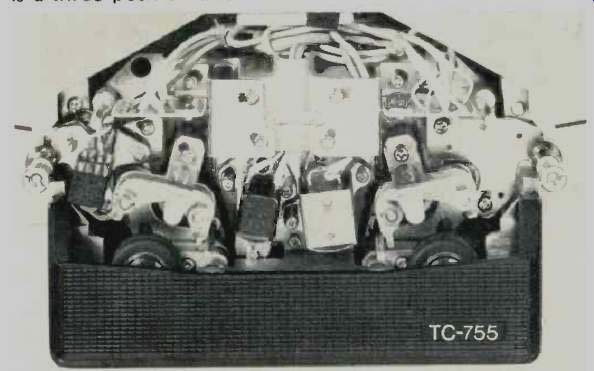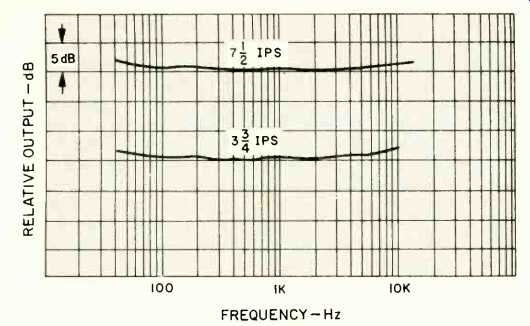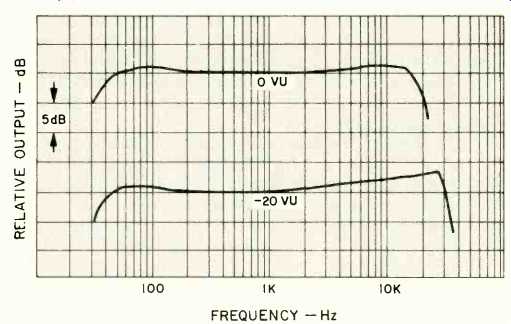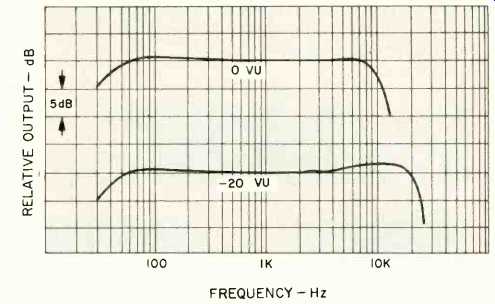
MANUFACTURER'S SPECIFICATIONS
Speeds: 3 3/4 and 7 1/2ips. Tracks: 4, 2 channels. Heads: 3. Motors: 3. Frequency Response: 30 to 25,000 Hz ±3db at 7 1/2, 30 to 10,000Hz ±3dB at 3 ¾ ips. S/N Ratio: 56 dB. Distortion: 1.2%. Bias Frequency: 160kHz. Wow & Flutter: 0.07% and 0.1% DIN. Headphones: 8 ohms.
Dimensions: 17 in. W. x 17 3/4 in. H. x 8 3/4 in. D.
Weight: 53 lbs.
Price: $699.00
If you ask somebody in the street, just anybody, to name a make of tape recorders today, chances are he'll immediately say "Sony." This is not surprising since Sony makes more tape recorders than anyone else and that mythical man in the street could be in America, Europe, Asia-almost anywhere in the world. Sony recorders range from inexpensive cassette portables to very expensive professional grade open-reel machines with logic control, sync sound, and all kinds of gadgets to please the enthusiast. The model reviewed here, the TC-755, is a sophisticated 4-track machine with logic control, provision for 10-in. reels, monitor heads, and many other interesting features.
Styling is similar to other Sony machines with a brushed satin aluminum panel making a nice contrast with the charcoal black head cover and VU meters. On the extreme left, at the bottom, are two microphone sockets, and just above is a three-position attenuator--an unusual but most useful feature. To the right are two pairs of concentric controls for microphone and line inputs, and above those are two Record buttons and two lever switches for Tape Equalization and Bias Selection. To the left of the head assembly are three small black switches, one for Reel Size, one for Tape Speed (3 3/4 and 71/2 ips), and the third for Pause. This switch has an illuminated indicator as do the Record buttons. Under the head assembly is a timer switch and the two large VU meters, and to the right are four tape control buttons. Underneath those are separate tape Monitor switches for each channel, a dual-concentric line output control, the Power on/off switch and a Headphone socket. A digital counter is located between the tape reels. At the rear are the Line In and Line Out sockets plus a spare a.c. power outlet. The tape controls use a logic system and the merest touch is sufficient to operate them. That timer switch locks the machine in the Record mode so it can be switched on by an inexpensive commercial timer.
Three motors are used, a servo-controlled capstan motor for the capstan drive, and two induction types for the reels. There are actually two capstans, and this dual drive is mainly responsible for the exceptionally low wow and flutter. NAB reel adaptors are supplied for 10-in. reels--as can be seen from the photograph.

Fig. 1 Head assembly, viewed from above, with cover removed.

Fig. 2 Rear view, with cover removed.
Figure 3 shows the playback response with standard 7 1/2 and 3 3/4 test tapes, and Fig. 4 shows the Record/Play response from Sony 180 SLH tape at 7 1/2 ips. It will be seen that the 3 dB point is at an impressive 30 kHz with a gradual rise from about 5 kHz. Response at 3 3/4 ips is seen in Fig. 5, and here the 3 dB point is at 22 kHz-which would be considered quite remarkable for 7 1/2 ips not that long ago! Headroom at the faster speed is better, of course, and tape saturation is not significant below 20 kHz at the higher speed, as compared with 12 kHz for 3 3/4 ips. Figure 6 shows the distortion at 1 kHz, and it will be noted that the 3% distortion figure is not reached until the meters read +7VU and it is well below 1% at 0 VU. Distortion versus frequency is shown in Fig. 7; note that the increase at both ends of the frequency range is very low indeed.
Wow and flutter were the next measurements to be taken and they were among the lowest yet recorded (I) being less than 0.05% at 7 1/2 ips and 0.08% at 3 3/4 ips using the DIN standard. The specifications give DIN figures of 0.07% and 0.10% which would seem rather conservative--but this is not surprising as makers of top-quality equipment rarely make extravagant claims. In fact, H.W. Hellyer's Law states, "the specifications of a recorder are inversely related to its cost." And thus you can find unbranded "orphan" recorders boasting performance figures better than studio machines costing fifty times as much! The next measurement of the 755 was S/N ratio, and the figures were 67 dB at 7 1/2ips and 64.5 dB at 3 3/4 ips, referred to 0 VU using the standard A weighting. If the 3% figure is preferred, then both figures should be increased by 7 dB. The microphone input stage reduced the figures by 10 dB (A weighting). Input required for 0 VU was 55 mV for line and 180 microvolts for microphone with the attenuator switch at 0 dB. At this position, the overload point was 70 mV. The other two positions of the microphone attenuator switch gave cuts of 15 and 30 dB-more than adequate for dynamic microphones. Output, for 0 VU recording level, was 800 mV with the output level control at maximum. Amplifier gain was 5 dB, so in practice the output control would be turned down slightly so input and output signals could be compared by a flip of the tape monitor switch. Tape erase efficiency was checked last, and the average using three different tapes was 67 dB.

Fig. 3 Playback response at 3 3/4 and 7 1/2 ips, using standard test tape.

Fig. 4 Record/Play response at 7 1/2 ips with Sony SLH 180 tape.

Fig. 5 Record/Play response at 3 3/4 ips.

Fig. 6 Distortion at 1 kHz.

Fig. 7 Distortion vs. frequency.
Listening Tests
Operation of the 755 is simplicity itself and those feather touch logic control buttons make it completely foolproof.
There is little danger of breaking the tape-even if the wrong button is pressed by mistake. The line and microphone mixing facility was found to be most useful, and several tapes were made with speech introductions fading into music taken from discs and FM broadcasts. The 3 3/4 ips speed is perfectly adequate for most purposes; after all, a response extending well above 20 kHz is better than most program sources! However, the faster speed is audibly superior with music having high transient content.
The instruction manual gives bias and equalizer settings for a number of different tapes and among those tested with good results were Maxell UD35-7VP, Capitol FDS-1800, Fuji FG-150-7H, and Scotch Classic. It was not found necessary to use the microphone attenuator but it would certainly prove an advantage when recording an enthusiastic high-decibel rock group for instance-or even for close miking. It's really surprising to see how high transient peaks are on a monitor 'scope! The TC-755 is not cheap, at $699.00, but it is a well-engineered piece of equipment with fine performance. Not only that, it is beautifully-made, with first-class components, and should give many years of trouble-free service. What more could anyone want?
-George W. Tillett
(adapted from Audio magazine, Sept 1975)
Compare to:
Sony/Superscope TC-277-4 Quadradial tape deck (Aug. 1972)
Sony 880-2 Open Reel Tape Deck (Sept. 1976)
Pioneer tape decks (Aug. 1975)
Also see:
Sony tape decks (advertisement, Aug. 1975)
Sony STR-V7 stereo receiver (ad, Feb. 1979)
= = = =